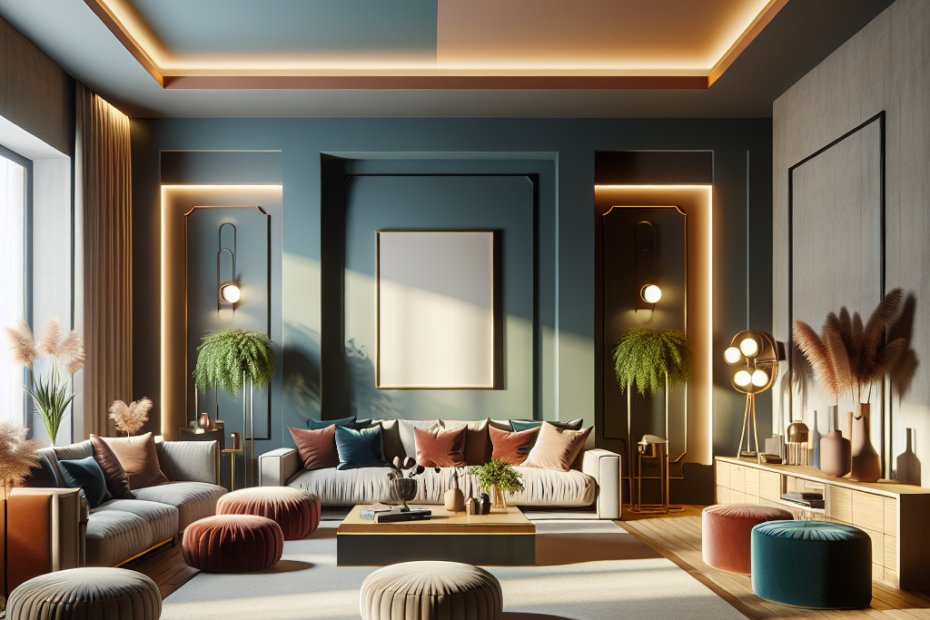Transforming Spaces with Accent Walls in Design: Creating Depth and Style
When they step into a room, individuals often look for a focal point that draws them in. In interior design, accent walls in design have become a key tool for achieving this effect. By using color, texture, and strategically chosen materials, accent walls can create depth and bring character to an otherwise plain space. Not only do they provide visual interest, but they also play a significant role in making rooms appear larger and more inviting.
Accent walls have grown in popularity over the years. According to a survey conducted by Home Improvement Research Institute in 2022, over 60% of homeowners have implemented accent walls in their interior design, seeing them as a cost-effective method to update the style of their homes without a complete overhaul.
The Science Behind Accent Walls
Accent walls work by utilizing contrasting colors or textures against a room’s existing décor. This contrast creates an optical illusion, impacting how individuals perceive the size and depth of a room. Typically, darker shades are used to ‘push’ a wall back visually, generating a sense of depth, while lighter colors can make spaces feel larger.
Incorporating textures like wood, stone, or even velvet enhances this effect. A textured accent wall not only adds depth but also introduces a tactile element that invites touch and interaction. The combination of these elements can dramatically transform the ambiance of a space.
Choosing the Right Wall
Not every wall is fit to be an accent wall. Usually, the best candidates are walls that already feature a natural focal point, like those behind a fireplace, bed, or a large piece of furniture. Designers often suggest considering:
- The wall with the least openings (doors and windows).
- Walls where a change can balance the room’s visual weight.
- Spaces where the color or texture complements other design elements.
Regardless of the choice, the goal is to bring the viewer’s attention naturally, enhancing both the wall and the features of the room.
Color and Material Considerations
| Color/Material | Effect on Space |
|---|---|
| Dark Colors | Creates Depth, Makes Room Feel Cozy |
| Light Colors | Makes Room Appear Larger, Offers Airy Feel |
| Textured Materials | Adds Warmth, Invites Interaction |
| Patterned Wallpapers | Introduces Complexity, Acts as a Conversation Starter |
The choice of color and material is crucial when implementing an accent wall in design. Selecting bold, rich hues can make a dramatic statement, while more subdued tones can subtly enhance room features. Experts in the field recommend aligning the accent wall’s color with the room’s theme. For example, serene blues and greens benefit bedrooms, promoting relaxation, while vibrant oranges and reds might be better suited for energizing living spaces.
Implementation Tips
Once they’ve chosen the wall and the materials, it’s time to consider execution:
- Test Colors and Textures: Before committing, it’s wise to sample paints and materials. Observing them at different times of day helps ensure the desired effect remains constant throughout various lighting conditions.
- Layer Elements: Adding artwork, mirrors, or shelves to an accent wall can enhance its impact. However, these should complement and not overpower the primary feature of the accent wall in design.
- Maintain Balance: While the accent wall is meant to stand out, it should not clash with the room’s existing décor. Consistency in style and color throughout the room maintains harmony.
For DIY enthusiasts and professional designers alike, incorporating an accent wall can be both fun and rewarding. They suggest brainstorming with color swatches, being fearless in trying new textures, and ultimately focusing on expressing personal style.
Key Takeaways
- Accent walls use color and texture to create depth, transforming plain spaces into interesting focal points.
- Choosing the right wall and material is crucial for achieving the desired effect.
- Accent walls enhance the room’s composition, making spaces appear larger or cozier depending on the color palette.
- Implementing an accent wall should be done in alignment with the room’s existing theme, ensuring balance and harmony.
FAQ
- What is an accent wall?
- Can accent walls work in small rooms?
- What materials can be used for an accent wall?
- How do I preserve the balance of a room with an accent wall?
- Should every room have an accent wall?
An accent wall is a single wall within a room that’s painted a different color or covered in a distinct material to stand out from the surrounding walls.
Yes, when done right, they can make small rooms feel larger by adding depth and dimension.
Materials like paint, wood, stone veneers, wallpaper, and even fabric can be used for creating accent walls.
Ensure the color or texture of the accent wall complements the rest of the room. Consistent styling and decorative elements help maintain balance.
No, not every room requires one. It’s about creating focal points where needed without overwhelming the space.
